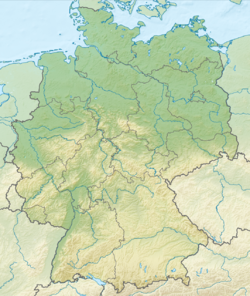Earth:Plattensandstein
From HandWiki
| Plattensandstein Stratigraphic range: Anisian ~247–242 Ma | |
|---|---|
| Type | Geological formation |
| Unit of | Upper Buntsandstein |
| Underlies | Röt Formation |
| Lithology | |
| Primary | Sandstone |
| Other | Mudstone |
| Location | |
| Coordinates | [ ⚑ ] : 47°36′N 7°48′E / 47.6°N 7.8°E |
| Paleocoordinates | [ ⚑ ] 12°48′N 18°48′E / 12.8°N 18.8°E |
| Country | |
The Plattensandstein is a Middle Triassic (Anisian) geologic formation in southern Germany and northern Switzerland. Fossil theropod tracks have been reported from the formation.[1]
Plattensandstein is used in Germany as a natural building stone. It derives its name from the fact that it is usually fissile into slabs with a thickness of several centimeters.
Fossil content
The formation has provided fossils of:
- Basileosaurus freyi
- Sclerosaurus armatus
See also
- List of dinosaur-bearing rock formations
- List of stratigraphic units with theropod tracks
- Flagstone, another scissile sandstone, which is used as a roofing material
References
- ↑ Weishampel et al., 2004, pp. 517-607
Bibliography
- Sues, H.-D., and R. R. Reisz. 2008. Anatomy and Phylogenetic Relationships of Sclerosaurus armatus (Amniota: Parareptilia) from the Buntsandstein (Triassic) of Europe. Journal of Vertebrate Paleontology 28. 1031-1042.
- Weishampel, David B.; Peter Dodson, and Halszka Osmólska (eds.). 2004. The Dinosauria, 2nd edition, 1–880. Berkeley: University of California Press. Accessed 2019-02-21. ISBN:0-520-24209-2
 |


